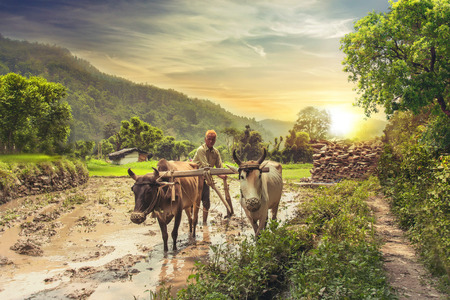Introduction to Agricultural Insurance in Rural India
Agricultural insurance has become a critical financial tool for millions of farmers across rural India. In a country where over 60% of the population depends on agriculture for their livelihood, ensuring economic security against unpredictable risks is essential. The Indian agricultural landscape is highly diverse, spanning smallholder farms to larger commercial operations, and is frequently exposed to threats like erratic monsoons, droughts, floods, pest attacks, and market price fluctuations. For these rural communities, even a single season’s crop failure can push families into debt and poverty. Agricultural insurance schemes—such as the Pradhan Mantri Fasal Bima Yojana (PMFBY)—are designed to provide a safety net by compensating farmers for losses caused by natural calamities or other unforeseen events. The significance of such protection extends beyond individual households; it helps stabilize local economies, encourages investment in better farming practices, and supports broader rural development. However, the socio-economic context in rural India presents unique challenges for effective implementation. Issues such as low literacy rates, limited access to banking and digital infrastructure, and deep-rooted mistrust towards formal institutions influence both the uptake and success of agricultural insurance programs. Understanding this context is vital when exploring the specific challenges faced in claim documentation and the solutions that can bridge the gap between policy intent and actual farmer benefit.
2. Common Challenges in Claim Documentation
For many farmers in rural India, the process of agricultural insurance claim documentation presents several persistent challenges. Understanding these barriers is crucial for improving claim settlement rates and ensuring that insurance actually serves its protective purpose. Below, we discuss the most significant obstacles faced by rural policyholders.
Lack of Awareness
Many farmers are not fully aware of the requirements and benefits associated with agricultural insurance policies. This lack of understanding often leads to incomplete or incorrect submissions when claims are initiated. Awareness campaigns are often limited in reach due to language diversity and remote locations.
Illiteracy and Language Barriers
A large proportion of India’s rural farming population is either illiterate or only comfortable with local dialects. Insurance documents and instructions are frequently provided in English or Hindi, making it difficult for farmers to fill out forms correctly or understand procedural requirements.
Inadequate Documentation
Farmers often struggle to produce the necessary documentation, such as land ownership records, crop sowing details, and damage assessment reports. Reasons include poor record-keeping habits, lack of formal land titles, and frequent reliance on informal tenancy agreements.
| Required Document | Common Issues Faced |
|---|---|
| Land Ownership Proof | No official title, disputes over ownership |
| Sowing Certificates | Poor record maintenance, missing documents |
| Damage Assessment Report | Lack of local surveyors, delays in verification |
Local Infrastructural Issues
The infrastructural limitations in rural areas further complicate documentation. Many villages have no reliable internet connectivity or access to digital services, leading to delays in submitting claims online or tracking their status. Additionally, frequent power cuts and long distances to insurance offices add to the difficulty.
Summary Table: Key Obstacles in Rural Claim Documentation
| Challenge | Description |
|---|---|
| Lack of Awareness | Insufficient knowledge about claim procedures and policy terms |
| Illiteracy & Language Barriers | Difficulty understanding forms and requirements due to language gaps |
| Poor Documentation Practices | Missing or incomplete paperwork required for claim approval |
| Infrastructure Deficits | No digital access, power issues, distant service centers |
Conclusion
Together, these challenges create a complex environment where genuine claims can be delayed or rejected altogether. Addressing these issues requires coordinated efforts from insurers, government agencies, and local community leaders to ensure that agricultural insurance truly benefits those who need it most.

3. Cultural and Linguistic Barriers
Rural India is a vibrant mosaic of languages, dialects, and cultural traditions. This diversity, while enriching, poses significant challenges in the agricultural insurance claim process. Most claim documents are drafted in English or Hindi, but farmers often speak regional languages such as Telugu, Tamil, Bengali, or Marathi—and may even use local dialects unfamiliar to outsiders. This linguistic gap creates confusion and leads to misinterpretation of critical instructions or requirements within the insurance documentation.
Moreover, traditional beliefs and cultural practices influence how rural communities perceive insurance itself. In many villages, there exists a general mistrust towards formal financial products or skepticism about the likelihood of receiving compensation from insurers. As a result, some farmers may be reluctant to submit claims or may not provide accurate information due to fears of rejection or misunderstanding of the process.
The impact of these barriers is evident in delayed submissions, incomplete documentation, and higher rates of rejected claims. Farmers might hesitate to ask for clarification or seek help due to social stigma or fear of appearing uninformed in front of officials. Additionally, government officers and insurance company agents often lack training in local languages and cultural sensitivities, further widening the communication gap.
To address these challenges effectively, it is essential for insurers to employ multilingual field agents and leverage local influencers who can bridge cultural divides. Simplifying claim forms by providing translations in regional languages, using pictorial representations, and organizing community awareness programs can also help demystify the process. By acknowledging and adapting to Indias diverse linguistic and cultural landscape, insurers can foster greater trust and ensure that agricultural insurance truly supports rural farmers in times of need.
4. Technological and Administrative Hurdles
When it comes to agricultural insurance claim documentation in rural India, technological and administrative barriers play a significant role in shaping the overall experience for farmers. Despite government efforts to digitise processes through schemes like Pradhan Mantri Fasal Bima Yojana (PMFBY), the benefits often fail to reach every corner of the countryside due to the prevailing digital divide and limited internet penetration.
Digital Divide and Internet Penetration
The disparity between urban and rural areas in terms of access to digital infrastructure remains stark. Many villages still lack stable internet connectivity, hindering farmers’ ability to submit digital claims or check the status of their applications online. The following table illustrates this divide:
| Region | Internet Penetration (%) | Smartphone Usage (%) |
|---|---|---|
| Urban India | 65 | 72 |
| Rural India | 31 | 38 |
Challenges with Smartphone Apps like PMFBY
While apps such as PMFBY have been introduced to streamline insurance processes, actual adoption remains low in rural areas due to factors like digital illiteracy, language barriers, and lack of awareness. Even when farmers possess smartphones, complex interfaces and inconsistent regional language support act as deterrents.
Bureaucratic Complexities
The administrative procedures tied to agricultural insurance claims are often lengthy and require multiple touchpoints with local authorities. Documentation requirements can be unclear or inconsistent, resulting in delays or rejection of claims. Farmers frequently need to interact with village-level officers, bank officials, and insurance agents, each adding a layer of bureaucracy that complicates the process.
Summary Table: Key Hurdles Faced by Rural Farmers
| Hurdle Type | Description | Impact on Claim Process |
|---|---|---|
| Technological | Poor internet & low app usage | Delayed submissions & lack of updates for farmers |
| Linguistic/Digital Literacy | Lack of training & language options in apps | Mistakes in documentation; incomplete forms |
| Bureaucratic/Administrative | Multiple approvals & unclear guidelines | Longer processing times; higher rejection rates |
The combination of these technological and administrative challenges creates significant roadblocks for rural Indian farmers seeking timely and successful settlement of their agricultural insurance claims.
5. Community-driven and Technological Solutions
Across rural India, the persistent hurdles in agricultural insurance claim documentation are being met with innovative, grassroots solutions and cutting-edge technology. Local communities have begun to mobilize self-help groups and farmer cooperatives, which provide peer-to-peer guidance on the claims process. These community-driven initiatives simplify paperwork for farmers who may struggle with literacy or lack awareness of required documentation. In parallel, a new wave of agri-tech startups is emerging, leveraging India’s rapid digital transformation. By developing mobile apps in regional languages and integrating features like geo-tagged photos, digital signatures, and automated weather data, these startups help farmers create verifiable digital records for insurance claims.
Digital Documentation: Bridging the Information Gap
One key breakthrough has been the use of digital documentation platforms tailored for rural users. These tools not only digitize traditional paperwork but also ensure secure storage and easy retrieval during claim submission. By partnering with local banks and Common Service Centres (CSCs), agri-tech firms enable farmers to upload claim documents directly from their villages, minimizing delays and reducing dependency on physical paperwork.
Role of Local Agents in Rural Outreach
Another essential link in this ecosystem is the network of local insurance agents and village-level entrepreneurs (VLEs). These trusted intermediaries bridge the gap between insurance companies and rural policyholders. With strong community ties, they assist farmers in accurately filling out forms, collecting necessary evidence, and explaining policy terms in vernacular languages. Their involvement ensures that even marginal farmers without smartphones can participate in the digital transition.
Towards Inclusive Claim Settlement
The synergy between community-driven efforts and technological advancements is making agricultural insurance more accessible for rural Indians. By combining local knowledge with digital innovations, these initiatives promise faster claim processing, greater transparency, and ultimately, improved financial resilience for India’s farming communities.
6. Policy Recommendations and Future Prospects
For agricultural insurance to truly benefit rural India, both insurers and policymakers must implement actionable changes tailored to the realities faced by farmers in these regions. Below, we present a set of practical suggestions, innovative models, and ways to integrate rural feedback for sustainable improvement in the claim documentation process.
Suggestions for Insurers and Policymakers
Insurers should streamline claim documentation procedures by introducing vernacular language forms and providing local support staff. Training village-level entrepreneurs or agricultural extension workers as insurance facilitators can bridge the gap between formal processes and rural customers. Policymakers, on the other hand, should mandate simplified documentation requirements and enforce timelines for claim processing, ensuring transparency and accountability in every step of the claim settlement journey.
Innovative Models for Rural Insurance Claims
Adopting technology-driven solutions such as mobile-based applications for submitting claims can significantly reduce paperwork barriers. The integration of satellite imagery and remote sensing data can help in faster verification of crop losses, thereby reducing dependency on physical documents and manual field surveys. Community-based claim assessment models—where local farmer groups participate in the verification process—can also improve trust and expedite settlements.
Integration of Rural Feedback
Continuous feedback collection from policyholders is crucial for improving service delivery. Insurers should establish regular feedback channels through SMS surveys or village-level meetings to capture ground realities and pain points in the documentation process. This data can be analyzed to identify recurring issues and inform further policy refinements. Furthermore, involving local governance bodies like Panchayats in the design and monitoring of insurance schemes ensures that solutions are rooted in community needs.
By aligning policy frameworks with innovative models and grassroots input, agricultural insurance schemes in rural India can become more accessible, transparent, and impactful. Such sustainable improvements will not only enhance financial protection for farmers but also foster long-term trust in insurance as a vital risk management tool across Bharat’s agrarian heartland.


